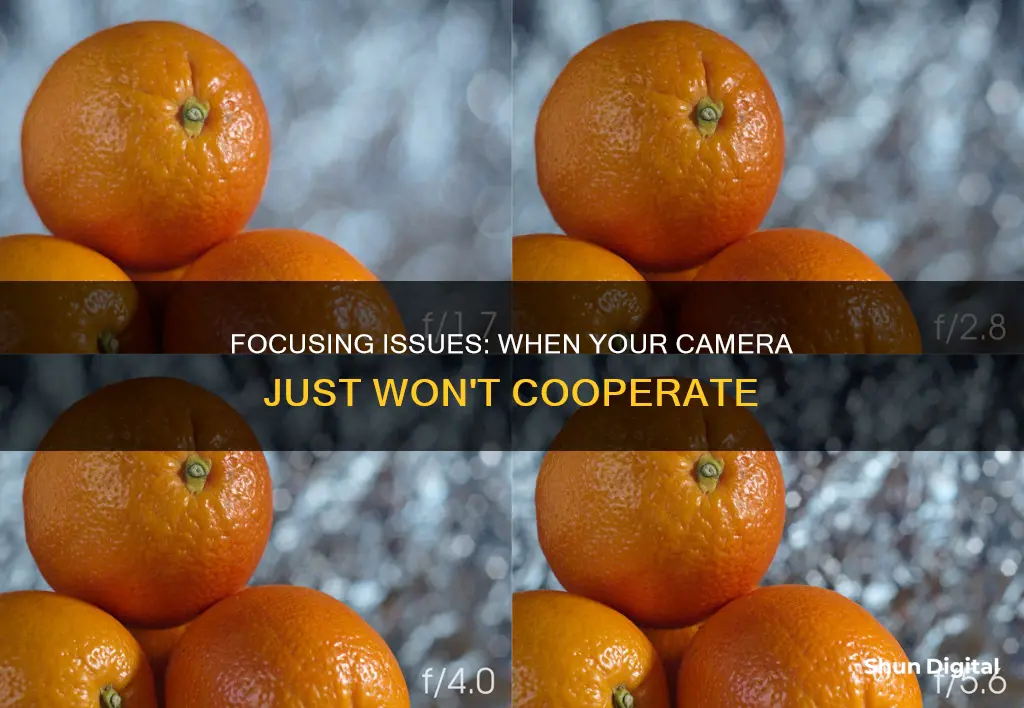
There are many reasons why a camera might not be able to focus on something. For instance, if the lens is dirty, the camera might not be able to focus properly. The lens also needs to be attached properly, or it won't be able to communicate with the camera body. If you're using autofocus, you need to ensure that the camera is set to autofocus mode, and that you're not too close to the subject. Focusing on a subject with a smooth surface and no contrast can also be difficult for cameras. In low-light conditions, the camera might struggle to focus due to a lack of light.
| Characteristics | Values |
|---|---|
| Camera lens is not clean | Dirt or foreign objects on the lens |
| Poor electrical connection between lens and camera | Dirty contact points on the lens or camera |
| Lens is not locked into place | The metal contacts on the camera and lens are not touching |
| Camera is in manual focus mode | AF/M switch on the lens is set to M |
| Lack of contrast in the scene | Focus point is aiming at a smooth area |
| Low light conditions | Insufficient light for the lens to focus |
| Moving target | Focusing technology is not advanced enough to capture a clear photo |
| Minimum focus distance not met | Camera is too close to the subject |
| Tracking auto-focus is enabled | Camera is locked onto a single subject |
What You'll Learn

Camera lens not clean
A dirty camera lens can be the reason why your camera cannot focus on something. Here are some tips on how to clean your camera lens:
Step 1: Use a Blower
Firstly, you should avoid blowing on the lens with your breath as your saliva or breath could increase condensation and even damage the lens coating. Instead, use a blower to get rid of any dust and residue on the lens.
Step 2: Use a Lens Brush
If using a blower isn't enough, you can use a lens brush to remove any remaining specs on the lens. It is recommended to use a lens brush with camel hair as it is thin and will be less harmful to the lens. Remember to not touch the brush with your hands as the oils on your hand can damage the lens.
Step 3: Use a Lens Cleaner
Using a lens cleaning solution should be a last resort as you risk leaving streaks on the lens. If you do use a lens cleaner, avoid spraying it directly on the lens. Instead, use a lens cleaning cloth or tissue to apply a few drops of the solution to the lens.
Step 4: Use a Cloth or Tissue
When using a liquid lens cleaner, make sure to wipe it off with a microfiber lens cloth or lens cleaning tissue. Do not use regular tissues as they could scratch the lens.
Other Tips:
- Avoid cleaning your lens too much as this can lead to scratches on the lens.
- Always use lens caps to protect your lens when it is stored in your camera bag or on a shelf.
- When changing lenses, hold the camera facing down to prevent dust particles from landing on the lens.
Understanding DC Camera Tickets and Fines
You may want to see also

Poor electrical connection between lens and camera
A poor electrical connection between the lens and the camera body can cause autofocus issues. This is often due to a communication error, which can be caused by something as small as a particle of dust.
The first step to resolving this issue is to check that the lens is attached correctly. Remove the lens and remount it, listening for a small click to indicate that it is locked into place. This is important because the metal contacts on the lens and camera body must be touching for the two to communicate properly.
If the lens is attached correctly, the next step is to check for dust or debris. Carefully inspect the lens mount on the camera body, ensuring that the pins are not damaged and that the mount is clean. Use a small bulb blower to gently blow air onto the lens mount, clearing away any dust or debris. It is important to blow from the inside out, as blowing from the outside can push dust into the camera body.
After cleaning, reattach the lens, ensuring that it is seated correctly and does not feel caught or forced. Once the lens is in place, put the battery back into the camera and try it out.
If the autofocus issue persists, the problem may lie with the lens itself. Try attaching a different lens to the camera to determine if the issue is with the lens or the camera body. If the camera focuses properly with a different lens, the original lens may need to be repaired or replaced.
Choosing the Right Batteries for Your Action Camera
You may want to see also

Camera too close to subject
If your camera is too close to the subject, it may not be able to focus. This is because every lens has a minimum focus distance, meaning it cannot focus on something that is closer than a certain distance. For most non-macro lenses, this is about one foot or so, but it's always a good idea to check the specifications of your lens if you're unsure.
If you are too close to the subject and your camera is unable to focus, the solution is simple: just back up a little and try again.
It's also worth noting that the distance from the camera to the subject can affect the perspective of the image. Changing the distance from the camera to the subject will change the relationship between the foreground subjects and the background elements. So, if you move closer to the main subject and zoom out to maintain the same subject size, the relationship between the subject and the background will change dramatically.
In addition, moving closer to the subject can make it more difficult to keep the camera steady, which can result in blurry photos. So, if you're having trouble getting a clear shot, try backing up a little to increase the distance between the camera and the subject.
Autofocus Feature in Miniature Cameras Explained
You may want to see also

Poor lighting
To address this issue, it is recommended to increase the amount of light available to the camera. This can be achieved by utilising a lens with a larger maximum aperture, such as a 50mm f/1.8 or 35mm f/1.8 lens. These lenses allow more light to reach the camera's sensor, improving its ability to focus. Additionally, some cameras offer a ""focus assist" mode, which employs a quick burst of light from the camera's flash to aid in focusing.
Another strategy is to utilise the "live view" feature, if available on your camera. By zooming in on the view in live view, you can take advantage of any available light to help the camera focus. Adjusting the ISO setting to a higher value can also help in low-light situations. While this may introduce noise or graininess to the image, it can be a useful solution for ensuring proper focus.
In extremely low-light conditions, adding an external light source, such as a flashlight, can be beneficial. By temporarily illuminating the subject or scene, you can assist the camera in achieving the correct focus. Once the focus is locked, you can turn off the flashlight and capture the image as desired.
It is worth noting that some cameras perform better in low-light situations than others. Modern mirrorless cameras, for example, have advanced autofocus systems that excel in such challenging lighting conditions. Understanding the capabilities of your camera and utilising its available features can help you overcome poor lighting situations and capture sharper, more focused images.
Mailing Rechargeable Camera Batteries: Safe Handling and Shipping
You may want to see also

Camera case partially blocking lens
If your camera case is partially blocking the lens, you will likely experience issues with your camera's focus. This is a common issue with iPhone cameras, where the case obstructs the camera lens or flash, or affects the iPhone's optical stabilisation. Removing the case is the first step to resolving this issue.
In some cases, the camera lens may appear to be blocked, but there is no visible obstruction. This could be due to a stuck shutter, which may require mechanical repair.
Additionally, issues with focus can also be caused by factors such as the camera's proximity to the subject, lighting conditions, and the AF/M switch setting. Ensuring that the camera is not too close to the subject, adjusting the lighting, and checking the AF/M switch setting to ensure it is set to autofocus can help resolve focus problems.
It is also important to keep your camera lenses clean and free of dust, fingerprints, or other debris, as these can interfere with the camera's ability to focus properly.
Body-Cam Battery Life: How Long Does It Last?
You may want to see also
Frequently asked questions
There could be a number of reasons your camera won't focus. Firstly, check that the lens is clean and free of dust, smudges, or dirt. Next, ensure that the lens is attached properly and locked into place. You should also check that the AF/M switch on the lens is set to AF (Autofocus).
If the lens is clean and properly attached, the issue could be related to lighting conditions. Your camera may struggle to focus in low-light environments. Try using a lens with a larger maximum aperture to let in more light. Alternatively, use a flashlight or your camera's focus assist mode to improve focus in low-light conditions.
Check that you are not too close to the subject. Every lens has a minimum focus distance, and if you are closer than this distance, your camera may struggle to focus. Simply back up a little and try again.
If you're using a smartphone, such as an iPhone or a Samsung Galaxy, there are a few additional things to check. Ensure that your phone case is not blocking the camera lens or flash. Also, make sure that the Tracking Auto-focus feature is turned off, as this can cause the camera to lock focus on a single subject, making it seem like the rest of the scene is out of focus.







